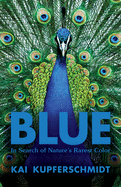
Since ancient times, humans have been captivated by the color blue--sometimes to the point of obsession. In Blue: In Search of Nature's Rarest Color, German science journalist Kai Kupferschmidt takes a fascinating and well-researched look at all aspects of this moody hue, including how people create it, talk about it and see it (or don't see it). Along his globetrotting journey, Kupferschmidt confirms that blue in the natural world is extremely hard to find--and some objects appear blue due to an elaborate trick of the light. As one example, cornflowers don't actually absorb any blue light at all. "In a sense, blue is what the plant rejects. Calling it 'blue' is a bit like calling a country club 'feminist' because it doesn't allow women."
Because of the color's scarcity, some scientists have devoted their careers to engineering blue plants and pigments. When Kupferschmidt travels to Japan to see blue chrysanthemums, the breathtaking results are bolstered by scientific fact. "I think of the retinal in the cones of my retina. We owe it to this plant molecule that we are able to see colors at all. Perhaps it is only fair that, in return, we have taught chrysanthemums how to be blue." As he examines the color's history--from the jewelry of the pharaohs to the accidental development of poisonous cyanide--Kupferschmidt writes with a welcoming mix of knowledge and childlike wonder. The book also features striking illustrations of pigments, flowers and stones that underscore his message that the experience of blue is both universal and deeply personal. --Angela Lutz, freelance reviewer

